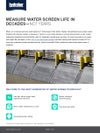Removing Limitations from the Oil and Gas Industry
Avoid the shortcomings of traditional screening technologies
- Insights
- February 22, 2024

The only two resources as important to the fossil fuel industry as oil and gas?
“Time and money,” says David Weller, Project Manager for Hydrolox.
And with traditional water screen technology, refineries are guaranteed to burn more of both.
“If you always have to work on a broken screen,” Weller continues, “then you're not able to get other things done that help the plant run efficiently.”
But the limitations of traditional water screens are usually taken for granted at plants—and long-accepted by the industry at large. When asked, many operators don’t even realize they’re experiencing difficulties. To them, it’s just the ungovernable nature of water intake as it’s been for 100 years.
We figured it was time for a new industry standard.
“We’re able to come at it from a new perspective,” Weller says.
“We’re not stuck in the traditional paradigm of what an intake has to look like. It doesn’t have to be a certain size. Its maintenance doesn’t have to be frequent or complex. Its lifespan can be much, much longer.”
We talked with our experts to discuss the future of oil and gas, traditional solutions’ shortcomings in that future, and what effect Hydrolox technology is having on the industry.
Off the Chain
“I haven’t talked to a maintenance person yet who doesn’t have water screen issues,” Weller says. “Anybody in the industry who says they don’t have problems at their intakes is emphatically corrected by the person who has to live with them.”
Unfortunately, outside of interpersonal interaction, the industry’s perception at large can be difficult to change. Traditional chain-driven steel screens are a ubiquitous technology. They’ve been around for 100 years, unchanged. When a technology is that deeply entrenched, its inconveniences seem less like limitations and more like intrinsic qualities.
“They don’t have to live with this status quo,” says Tim Woodrow, Vice President for Hydrolox. “Our solution is both a new paradigm and a field-proven technology. It solves all the problems they live with and accept as normal.”
Perhaps the biggest limitation our screens remove is the need for a chain to drive them.
“On a traditional screen, those big metal chains go in and out of the water,” Weller says. “They rust, they corrode, they bind up, and they just have an impossible time running 24/7. If you’ve left your bike outside in the rain and found your chain all rusted and gunked up, that’s what’s happening to these every day.”
Chains also by nature feature a lot of open area, allowing for debris and aquatic wildlife to bypass the screening.
“Water wants to find its own level,” Weller explains. “It’ll go through the sides. It can go through the cracks. It’ll carry debris everywhere you don’t want it to. It’ll find your pump.”
Really, it’s what all Intralox products are doing: reducing downtime, increasing uptime, simplifying maintenance, and adding value. Hydrolox just takes that to the next level.
Project Manager for Hydrolox
Our chainless design, which includes permanent side seals, completely eliminates this bypass—and a huge source of maintenance headaches.
“In addition to eliminating chains,” Woodrow says, “we kept all serviceable parts above the waterline.”
“It removes a huge maintenance drain for these plants,” Weller adds. “If you can reduce your monthly screen maintenance from more than 10 hours to one or two—which is what we’ve done in a lot of plants—you really free up your teams to do other things that are higher priorities.”
One of our partners, for instance, reduced their yearly maintenance costs from $334,300 to $4,110 simply by installing our screens. They’re up and running 24/7 with no problems while staff address other functions around the refinery.
“Really, it’s what all Intralox products are doing: reducing downtime, increasing uptime, simplifying maintenance, and adding value” Weller continues. “Hydrolox just takes that to the next level.”
The Long Run
These extreme cost savings come from improved maintenance as well as a reduced need for spare and replacement parts.
“A nuclear plant was spending approximately $2,000,000 on their 18 screens,” Weller says. “Now they’re spending $50,000. That amount of money—they’re scratching their head. They don’t understand how it’s possible just by replacing their screens.”
Because these plants have to work on their screens so frequently, they’re accustomed to storing spare parts on-site. Their providers often suggest they do so.
“Our competitors might not put this in print,” Woodrow says, “but they sell screens very cheaply and then make a lot of money selling spare parts and offering services to repair those screens.”
“A lot of our competitors have a field service team,” Weller says. “They talk to you about how they can roll out with their trucks and their gear and take care of your screen problems.”
Hydrolox screens, however, remove that need for frequent servicing and repairs. “We don’t have that truck,” Weller continues.
“We have field service people who’ll consult, tell you how to install it, and tell you how to troubleshoot it. But we’re not coming after you every year for the maintenance package or the service package or the spare parts that you need to stay online—because quite frankly, you don’t need them.”
Our technology also eliminates the start-and-stop operation that can throttle production—a value proposition familiar to anyone who’s worked with Intralox.
Success Spotlight: North American Refinery
Installing Hydrolox screens saves North American Refinery $300,000+ per year in maintenance
“Our partners turn them on and let them go with no worries,” Weller says. “It might be a new technology—newer than what they've had installed for the last 40 to 50 years—but it’s proven. We’ve already been working with and improving this technology at Intralox for the last 50 years.”
Proven is right. A set of nine Hydrolox screens installed between 2015 and 2017 has amassed more than 500,000 hours of runtime without a mechanical failure. A set of 18 installed in 2017 and 2018 at the nuclear plant Weller mentioned has collected more than 800,000 hours.
“One of them ran for almost 700 days continuously without any maintenance other than greasing the bearings and flushing out the spray bar,” Weller says. “That’s incredible performance and great labor savings for the plant.”
What this reliable performance has meant for our partners’ total cost of ownership (TCO) can sound too good to be true.
“The up-front investment in Hydrolox screens pays for itself very quickly,” Weller says. “Adding all these savings up, we find our partners’ return on investment is within the four-year warranty period on our screens. After those four years, these plants benefit from all our savings in perpetuity; they just compound year in and year out. The TCO over 10 or 20 years works out to be something like a third or less than that of a traditional screen. And that’s assuming the traditional screen lasts 20 years.”
“This is the Intralox methodology,” Woodrow says. “We provide the very best equipment we can. Our screens are meant to be put in the well and stay there for their entire operational life. At the moment, we’re getting past 20 years on some of our installs without having to go out for any service.”
“We’ll check in yearly to make sure things are going well,” Weller says. “Otherwise, we shake your hand and tell you to call us if there are problems. There won’t be.”
Download the industry highlight
Want to learn more about the Hydrolox design features changing the oil and gas industry’s expectations of their water screen technology?
A Future Powered by You
The lack of post-installation service needed on Hydrolox screens is due as much to our robust design as our insistence on collaborative partnership.
“We always want to be that innovative partner,” Weller says. “Let’s not talk first about what your intake should look like—that’s your paradigm. Let’s look at what you want it to deliver. Let’s look at what the environment provides us. Let’s talk long-term strategy. If we collaborate from the get-go, maybe we find five Hydrolox screens deliver as much or more performance than the eight drum screens you’re used to needing.”
This partnership is especially important as we move into new regions overseas.
“We design our frames, but we want the metal work itself done in-region,” Weller explains. “Many screen manufacturers have them built in other countries and shipped in. There’s no in-country value there. There’s no development of the local infrastructure or industry.”
By partnering with firms local to these countries, we maintain our industry-best lead times on shipment.
“The only things coming from the U.S. are the mesh and the designs,” Weller says. “Using the expertise of local players is a game-changer for these plants. It’s not on a ship for three to six weeks or longer. We can put it on a truck just like we do in the U.S.
“It does a lot for our partners’ peace of mind to know that it’s being built in-country,” he continues. “They can go see it. They can touch it.”
“There are also strict localization requirements in regions like the Middle East,” adds Gianluca Genchi, Global Business Development Manager for Hydrolox. “Having strong fabrication partners on the ground that can locally fabricate our products not only accelerates the whole process and delivery time but also increases our in-country value.”
This agile, collaborative approach to production will prove valuable as the industry itself changes.
“I see the oil and gas industry shifting toward green hydrogen production,” Genchi says. “Many oil and gas companies will become cleaner and reduce their carbon footprint through green hydrogen and carbon capture and storage, or maybe an integrated mix.”
“Hydrogen production is ramping up all over the world,” Weller adds. “It’s possibly the biggest growth industry for the next decade plus. There are a lot of projects planned around the world now, and they’ll need the best, strongest, most reliable screens on the market. We can help them meet these new demands.”
Expect More from Your Water Screens
Whatever those changing demands amount to, you can count on Hydrolox innovation to meet them with a low-maintenance, cost-effective solution.
“It’s the Intralox method again,” Woodrow says. “Developing a deep understanding of the problem, designing a solution for its requirements, and then supplying it to our partners reliably and without hassle. It really has helped us as we entered the traveling water screen market.”
And so far, the market’s response has been ecstatic.
“We joke,” Weller says, “our customers never buy just one screen. Where we do sell one screen, we know that in a year of two they’ll say, ‘We haven’t really touched this thing. Let’s change out the entire plant.’”
So when your plant is ready to relieve the water screen woes it’s lived with for decades, you know who to call for a replacement.
And you can always start with one.


